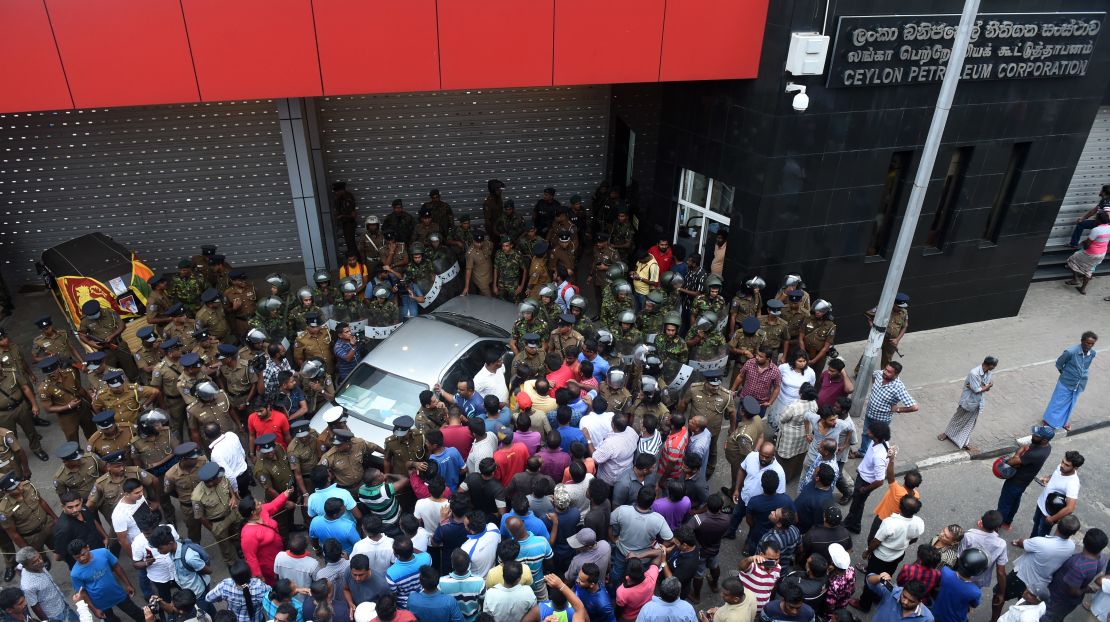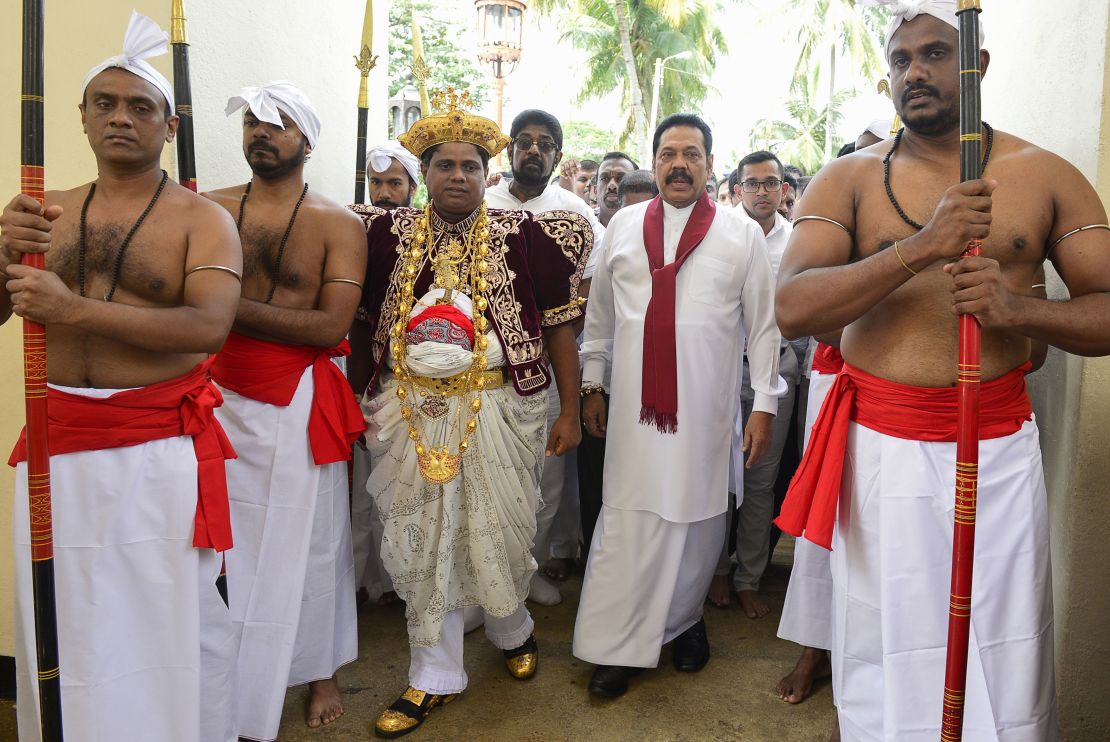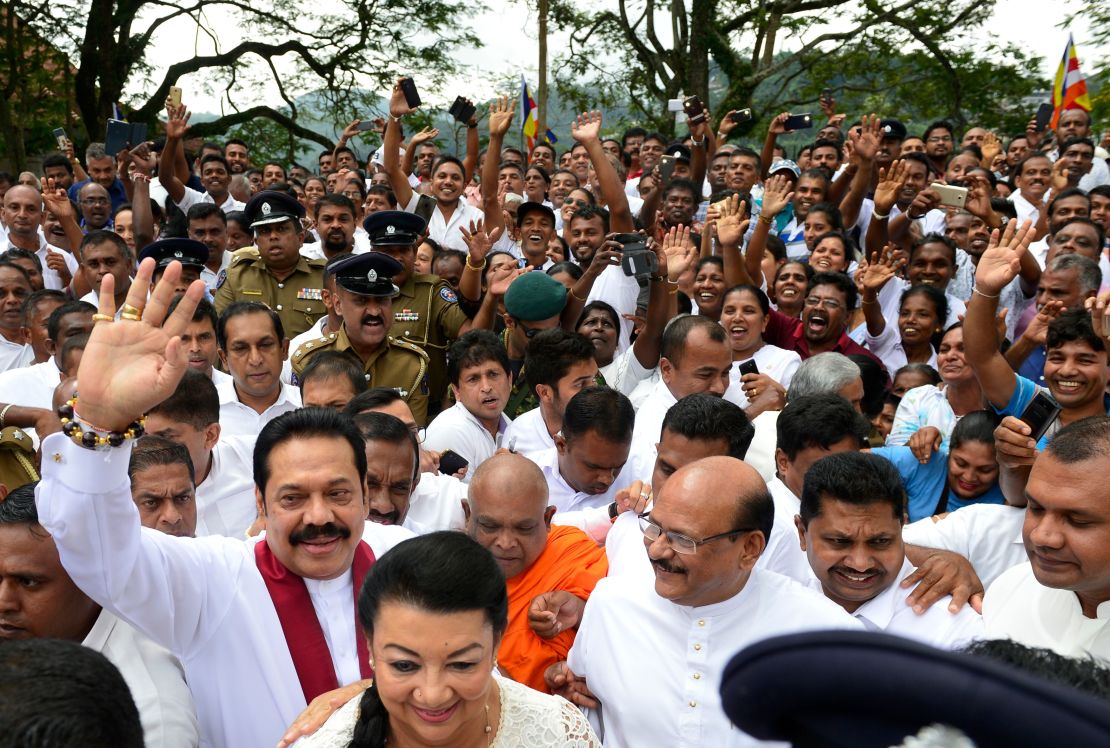One person has been killed in Sri Lanka after the bodyguards of a deposed government minister opened fire on a crowd of protestors amid a worsening constitutional crisis.
Sunday’s shooting follows a tumultuous 48-hours in the island nation, as the country comes to grips with President Maithripala Sirisena’s shock dismissal of his cabinet, the suspension of parliament, and the appointment of former strongman president Mahinda Rajapaksa as the new prime minister.
The shooting occurred on Sunday, as crowds loyal to the president attempted to prevent recently deposed petroleum minister Arjuna Ranatunga from entering a government building in the capital, Colombo.
As the crowds surged forward, bodyguards of Ranatunga, a former Sri Lankan cricket captain, opened fire, killing one and injuring three others. One bodyguard has since been taken into custody and an investigation was under way, police spokesperson Ruwan Gunasekera confirmed.
In the immediate aftermath of the shooting, Ranatunga was rushed into the building, which houses the headquarters of the Ceylon Petroleum Corporation, a national oil and gas company.
Speaking to reporters later Sunday, after being rescued by police commandos, Ranatunga said his bodyguards opened fire because the crowd “was trying to kill me.”

Constitutional crisis
The incident is the first reported outbreak of violence since Sirisena’s televised address Friday announcing the sacking of Prime Minister Ranil Wickremesinghe and the appointment of Rajapaksa.
Wickramasinghe, who insists he is still prime minister, has denounced the move as unconstitutional, sparking a standoff between the two groups of supporters.
Under Sri Lanka’s constitution, the president, who maintains executive powers, can appoint a new prime minister once the current premier has lost control of parliament.
At present, Wickremesinghe’s United National party (UNP) hold a plurality in Sri Lanka’s 225-seat assembly, and would be unlikely to support the new measures. However, on Saturday, Sirisena moved to suspend Parliament until mid-November.
The move allows supporters of Sirisena and Rajapaksa an opportunity to secure votes ahead of parliament’s resumption, potentially opening the way for the new prime minister to secure a majority and shut down any attempt to push through a no confidence vote.
Wickramasinghe was set to meet senior members of the UNP at the prime ministerial residence for discussions Monday.
Speaking to CNN Friday evening, Rajapaksa said it would take a week before a new cabinet is put in place. He said the new cabinet would represent a “grand coalition” that would have a majority of more than 113 seats.
On Sunday, the Speaker of the Parliament, Karu Jayasuriya, appeared to back Wickremesinghe, saying in a letter to Sirisena that the suspension would have “serious and undesirable consequences.”
Several hundred supporters of Wickramasinghe have since gathered outside his official home in the capital, where he has remained holed-up since Friday’s announcement, waiving flags and signs denouncing Sirisena.
In a statement, US State Department spokeswoman Heather Nauert said Washington is following the events in Sri Lanka “with concern” and called on Sirisena to and the Speaker “to immediately reconvene parliament and allow the democratically elected representatives of the Sri Lankan people to fulfill their responsibilities.”
In remarks Sunday, Sirisena rejected claims that the move was unconstitutional, telling supporters that “the appointments were made totally in accordance with the constitution and the on advice of legal experts.”

Rajapaksa comeback
The return of Rajapaksa marks an unlikely comeback for the two-time former president.
Sirisena and Wickramasinghe had originally joined forces to defeat Rajapaksa, who was unceremoniously voted out of office in 2015, amid allegations of corruption, nepotism and war crimes.
Considered a military hero among supporters, 72-year-old Rajapaksa was first elected president in 2005 and returned to office in 2010, a year after government forces routed Tamil rebel groups to end the country’s brutal 25-year civil war.
His sudden return to front line national politics comes amid months of infighting between Wickremesinghe’s UNP and Sirisena’s United People’s Freedom Alliance (UPFA).
Sirisena has spoken out publicly against Wickremesinghe’s supposed inaction, accusing the now deposed prime minister of inadequately investigating an alleged assassination plot targeting the president.
In his speech Friday, Sirisena again referenced the assignation plot, alleging that a cabinet minister was involved. The president did not name the cabinet minister in the alleged plan.
“Under these political problems, economic troubles, and the strong plot to assassinate me, the only alternative open to me was to invite former president Mahinda Rajapaksa and appoint him as prime minister to form a new government,” said Sirisena.
The current administration was formed in 2015 with the help of a disparate coalition of minority groups, promising a more decentralized, transparent form of governance that would usher in a new post-war era of prosperity for the island nation.
Instead, Sirisena, a former health minister under Rajapaksa, has struggled to maintain unity among his coalition partners while attempting to implement his ambitious reform agenda.

Lingering controversies
Rajapaksa remains a controversial figure in Sri Lanka, where scars from the decades-long civil war have yet to heal.
A 2011 UN report found credible allegations of war crimes and crimes against humanity committed by both sides during the final stages of the fighting.
Rajapaksa has long dismissed the report, and while in power refused to open an internal investigation into the findings.
According to the UN report, between September 2008 and May 2009, tens of thousands of civilians were killed in Vanni in northern Sri Lanka, a period that coincides with an advancement into the same area by the Sri Lankan army.
Rajapaksa’s brother, Gotabaya Rajapaksa, was Sri Lanka’s defense secretary at the time and in charge of government forces.
The government described the report as “biased, baseless and unilateral.”
Steve George wrote from Hong Kong and Iqbal Athas wrote and reported from Colombo, Sri Lanka.


